Hopf Bifurcation, Periodic Solutions, and Control of a New 4D Hyperchaotic System
Abstract
1. Introduction
2. Description of the Model
3. Stability Analysis and the Existence of Hopf Bifurcation
3.1. Equilibrium Stability
3.2. Existence of a Hopf Bifurcation
4. Direction and Stability of Bifurcating Periodic Solutions
- (i)
- If , the Hopf bifurcation is supercritical (subcritical), and for , the bifurcation has a periodic solution;
- (ii)
- If , the bifurcating periodic solutions are stable (unstable) on their orbits;
- (iii)
- If , the period of bifurcating periodic solutions increases or decreases.
5. Hyperchaos Control
6. Conclusions
Author Contributions
Funding
Data Availability Statement
Conflicts of Interest
References
- Rössler, O.E. An equation for hyperchaos. Phys. Lett. A 1979, 71, 155–157. [Google Scholar] [CrossRef]
- Vaidyanathan, S.; Volos, C.K.; Pham, V.T. Analysis, control, synchronization and SPICE implementation of a novel 4-D hyperchaotic Rikitake dynamo system without equilibrium. J. Eng. Sci. Technol. Rev. 2015, 8, 232–244. [Google Scholar] [CrossRef]
- Yang, J.; Wei, Z.; Moroz, I. Periodic solutions for a four-dimensional hyperchaotic system. Adv. Differ. Equ. 2020, 2020, 198. [Google Scholar] [CrossRef]
- Chen, Y.; Yang, Q. A new Lorenz-type hyperchaotic system with a curve of equilibria. Math Comput. Simulat. 2015, 112, 40–55. [Google Scholar] [CrossRef]
- Leutcho, G.D.; Wang, H.; Fozin, T.F.; Sun, K.; Njitacke, Z.T.; Kengne, J. Dynamics of a new multistable 4D hyperchaotic Lorenz system and its applications. Int. J. Bifurcat. Chaos 2022, 32, 2250001. [Google Scholar] [CrossRef]
- Jia, Q. Hyperchaos generated from the Lorenz chaotic system and its control. Phys. Lett. A 2007, 366, 217–222. [Google Scholar] [CrossRef]
- Wang, H.; Zhang, F. Bifurcations, ultimate boundedness and singular orbits in a unified hyperchaotic Lorenz-type system. Discret. Contin. Dyn. Syst. B 2020, 25, 1791–1820. [Google Scholar] [CrossRef]
- Lai, Q.; Lai, C.; Zhang, H.; Li, C. Hidden coexisting hyperchaos of new memristive neuron model and its application in image encryption. Chaos Solitons Fractals 2022, 158, 112017. [Google Scholar] [CrossRef]
- Liu, L.; Tang, X.; Jiang, X.; Xu, Z.; Li, F.; Li, Z.; Huang, H.; Ni, P.; Chen, L.; Xi, L.; et al. Physical layer encryption scheme based on cellular automata and DNA encoding by hyper-chaos in a CO-OFDM system. Opt. Express 2021, 29, 18976–18987. [Google Scholar] [CrossRef]
- Karmakar, J.; Pathak, A.; Nandi, D.; Mandal, M.K. Sparse representation based compressive video encryption using hyper-chaos and DNA coding. Digit. Signal Process. 2021, 117, 103143. [Google Scholar] [CrossRef]
- Xiu, C.; Zhou, R.; Zhao, S.; Xu, G. Memristive hyperchaos secure communication based on sliding mode control. Nonlinear Dyn. 2021, 104, 789–805. [Google Scholar] [CrossRef]
- Bian, Y.Y.; Yu, W.X. A secure communication method based on 6-D hyperchaos and circuit implementation. Telecommun. Syst. 2021, 77, 731–751. [Google Scholar] [CrossRef]
- Rech, P.C. Hyperchaos and multistability in a four-dimensional financial mathematical model. J. Appl. Nonlinear Dyn. 2021, 10, 211–218. [Google Scholar] [CrossRef]
- Li, X.; Rao, R.; Zhong, S.; Yang, X.; Li, H.; Zhang, Y. Impulsive control and synchronization for fractional-order Hyper-chaotic financial system. Mathematics 2022, 10, 2737. [Google Scholar] [CrossRef]
- Yan, S.L. Study of an erbium-doped fiber three-ring laser guiding a hyperchaos series synchronization network link. ICNCIS SPIE 2022, 12503, 127–130. [Google Scholar]
- Yan, S.L. Study of hyperchaos resulting from an erbium-doped fibre three-ring laser system. Electron. Lett. 2022, 58, 288–289. [Google Scholar]
- Kingston, S.L.; Balcerzak, M.; Dana, S.K.; Kapitaniak, T. Transition to hyperchaos and rare large-intensity pulses in Zeeman laser. Chaos 2023, 33, 023128. [Google Scholar] [CrossRef]
- Vaidyanathan, S.; He, S.; Simbas, A. A new multistable double-scroll 4-D hyperchaotic system with no equilibrium point, its bifurcation analysis, synchronization and circuit design. Arch. Control Sci. 2021, 31, 99–128. [Google Scholar]
- Luo, J.; Qu, S.; Chen, Y.; Chen, X.; Xiong, Z. Synchronization, circuit and secure communication implementation of a memristor-based hyperchaotic system using single input controller. Chin. J. Phys. 2021, 71, 403–417. [Google Scholar] [CrossRef]
- Vaidyanathan, S.; Sambas, A.; Azar, A.T.; Rana, K.; Kumar, V. A new 5-D hyperchaotic four-wing system with multistability and hidden attractor, its backstepping control, and circuit simulation. In Backstepping Control of Nonlinear Dynamical Systems; Academic Press: Cambridge, MA, USA, 2021; pp. 115–138. [Google Scholar]
- Daum, H.H.; Tusset, A.M.; Ribeiro, M.A.; Balthazar, J.M.; Bueno, A.M.; Litak, G. Dynamics and control of a vibrating system with hyperchaotic behavior using an electronic circuit implementation. Braz. J. Phys. 2022, 52, 104. [Google Scholar] [CrossRef]
- Pecora, L. Hyperchaos harnessed. Phys. World 1996, 9, 17. [Google Scholar] [CrossRef]
- Ayub, J.; Aqeel, M.; Abbasi, J.N.; Sunny, D.A.; Rana, Z. Switching of behavior: From hyperchaotic to controlled magnetoconvection model. AIP Adv. 2019, 9, 125235. [Google Scholar] [CrossRef]
- Fiaz, M.; Aqeel, M.; Marwan, M.; Sabir, M. Retardational effect and hopf bifurcations in a new attitude system of quad-rotor unmanned aerial vehicle. Int. J. Bifurcat. Chaos 2021, 31, 2150127. [Google Scholar] [CrossRef]
- Panday, P.; Pal, N.; Samanta, S.; Chattopadhyay, J. Stability and bifurcation analysis of a three-species food chain model with fear. Int. J. Bifurcat. Chaos 2018, 28, 1850009. [Google Scholar] [CrossRef]
- Mahmoud, G.M.; Ahmed, M.E.; Mahmoud, E.E. Analysis of hyperchaotic complex Lorenz systems. Int. J. Mod. Phys. C 2008, 19, 1477–1494. [Google Scholar] [CrossRef]
- Yu, F.; Qian, S.; Chen, X.; Huang, Y.; Liu, L.; Shi, C.; Cai, S.; Song, Y.; Wang, C. A new 4D four-wing memristive hyperchaotic system: Dynamical analysis, electronic circuit design, shape synchronization and secure communication. Int. J. Bifurcat. Chaos 2020, 30, 2050147. [Google Scholar] [CrossRef]
- Singh, J.P.; Roy, B.K. Hidden attractors in a new complex generalised Lorenz hyperchaotic system, its synchronisation using adaptive contraction theory, circuit validation and application. Nonlinear Dyn. 2018, 92, 373–394. [Google Scholar] [CrossRef]
- Fonzin Fozin, T.; Megavarna Ezhilarasu, P.; Njitacke Tabekoueng, Z.; Leutcho, G.D.; Kengne, J.; Thamilmaran, K.; Mezatio, A.B.; Pelap, F.B. On the dynamics of a simplified canonical Chua’s oscillator with smooth hyperbolic sine nonlinearity: Hyperchaos, multistability and multistability control. Chaos 2019, 29, 113105. [Google Scholar] [CrossRef]
- Rahim, M.F.A.; Natiq, H.; Fataf, N.A.A.; Banerjee, S. Dynamics of a new hyperchaotic system and multistability. Eur. Phys. J. Plus 2019, 134, 499. [Google Scholar] [CrossRef]
- Ouannas, A.; Grassi, G.; Ziar, T.; Odibat, Z. On a function projective synchronization scheme for non-identical fractional-order chaotic (hyperchaotic) systems with different dimensions and orders. Optik 2017, 136, 513–523. [Google Scholar] [CrossRef]
- Vaidyanathan, S.; Azar, A.T.; Boulkroune, A. A novel 4-D hyperchaotic system with two quadratic nonlinearities and its adaptive synchronisation. Int. J. Control Autom. 2018, 12, 5–26. [Google Scholar] [CrossRef]
- Wei, Z.; Pham, V.T.; Khalaf, A.J.M.; Kengne, J.; Jafari, S. A modified multistable chaotic oscillator. Int. J. Bifurcat. Chaos 2018, 28, 1850085. [Google Scholar] [CrossRef]
- Wei, Z.; Zhu, B.; Escalante-González, R.J. Existence of periodic orbits and chaos in a class of three-dimensional piecewise linear systems with two virtual stable node-foci. Nonlinear Anal. Hybrid Syst. 2021, 43, 101114. [Google Scholar] [CrossRef]
- Wei, Z.; Li, Y.; Moroz, I.; Zhang, W. Melnikov-type method for a class of planar hybrid piecewise-smooth systems with impulsive effect and noise excitation: Heteroclinic orbits. Chaos 2022, 32, 103127. [Google Scholar] [CrossRef]
- Li, Y.; Wei, Z.; Aly, A.A. A 4D hyperchaotic Lorenz-type system: Zero-Hopf bifurcation, ultimate bound estimation, and its variable-order fractional network. Eur. Phys. J. Spec. Top 2022, 231, 1847–1858. [Google Scholar] [CrossRef]
- Zhang, J.; Hou, J.; Xu, L.; Xie, Q. Dynamical analysis, circuit implementation, and simultaneous application of a novel four-dimensional hyperchaotic system based on cosine functions. Microelectron. Eng. 2023, 271–272, 111939. [Google Scholar] [CrossRef]
- Liu, J.; Sun, Y.; Yao, M.; Ma, J. Stability Analysis and Nonlinear Vibrations of the Ring Truss Antenna with the Six-Dimensional System. J. Vib. Eng. Technol. 2022, 11, 899–920. [Google Scholar] [CrossRef]
- Zhu, E.; Xu, M.; Pi, D. Anti-control of Hopf bifurcation for high-dimensional chaotic system with coexisting attractors. Nonlinear Dyn. 2022, 110, 1867–1877. [Google Scholar] [CrossRef]
- Yan, S.; Wang, E.; Wang, Q.; Sun, X.; Ren, Y. Analysis, circuit implementation and synchronization control of a hyperchaotic system. Phys. Scr. 2021, 96, 125257. [Google Scholar] [CrossRef]
- Al-Talib, Z.S.; Al-Azzawi, S.F. Projective synchronization for 4D hyperchaotic system based on adaptive nonlinear control strategy. Indones J. Electr. Eng. Comput. Sci. 2020, 19, 715–722. [Google Scholar] [CrossRef]
- Hassard, B.D.; Kazarinoff, N.D.; Wan, Y.H. Theory and Applications of Hopf Bifurcation; CUP Archive: Cambridge, UK, 1981. [Google Scholar]
- Cui, N.; Li, J. A new 4D hyperchaotic system and its control. Aims Math 2023, 8, 905–923. [Google Scholar] [CrossRef]
- Sprott, J.C. Some simple chaotic flows. Phys. Rev. E 1994, 50, 647–650. [Google Scholar] [CrossRef] [PubMed]
- Yang, Q.G.; Wei, Z.C.; Chen, G.R. An unusual 3D autonomous quadratic chaotic system with two stable node-foci. Int. J. Bifurcat. Chaos 2010, 20, 1061–1083. [Google Scholar] [CrossRef]
- Zhang, Z.H. Hopf bifurcation analysis and control of a new Lorenz-like system. In Proceedings of the 26th Chinese Control and Decision Conference (2014 CCDC), Changsha, China, 31 May–2 June 2014; pp. 1597–1601. [Google Scholar]
- Jafari, S.; Rajagopal, K.; Hayat, T.; Alsaedi, A.; Pham, V.-T. Simplest megastable chaotic oscillator. Int. J. Bifurcat. Chaos 2019, 29, 1950187. [Google Scholar] [CrossRef]
- Jafari, S.; Ahmadi, A.; Khalaf, A.J.M.; Abdolmohammadi, H.R.; Pham, V.-T.; Alsaadi, F.E. A new hidden chaotic attractor with extreme multi-stability. AEU Int. J. Elec. C 2018, 89, 131–135. [Google Scholar] [CrossRef]
- DeJesus, E.X.; Kaufman, C. Routh-Hurwitz criterion in the examination of eigenvalues of a system of nonlinear ordinary differential equations. Phys. Rev. A 1987, 35, 5288. [Google Scholar] [CrossRef]
- Guckenheimer, J.; Homles, P. Nonliear oscillstions, Dynamical systems, and bifurcations of vector field. Appl. Math. Sci. 1983, 42, 117–156. [Google Scholar]
- Cai, P.; Yuan, Z.Z. Hopf bifurcation and chaos control in a new chaotic system via hybrid control strategy. Chin. J. Phys. 2017, 55, 64–70. [Google Scholar] [CrossRef]
- Chien, F.; Chowdhury, A.R.; Nik, H.S. Competitive modes and estimation of ultimate bound sets for a chaotic dynamical financial system. Nonlinear Dyn. 2021, 106, 3601–3614. [Google Scholar] [CrossRef]
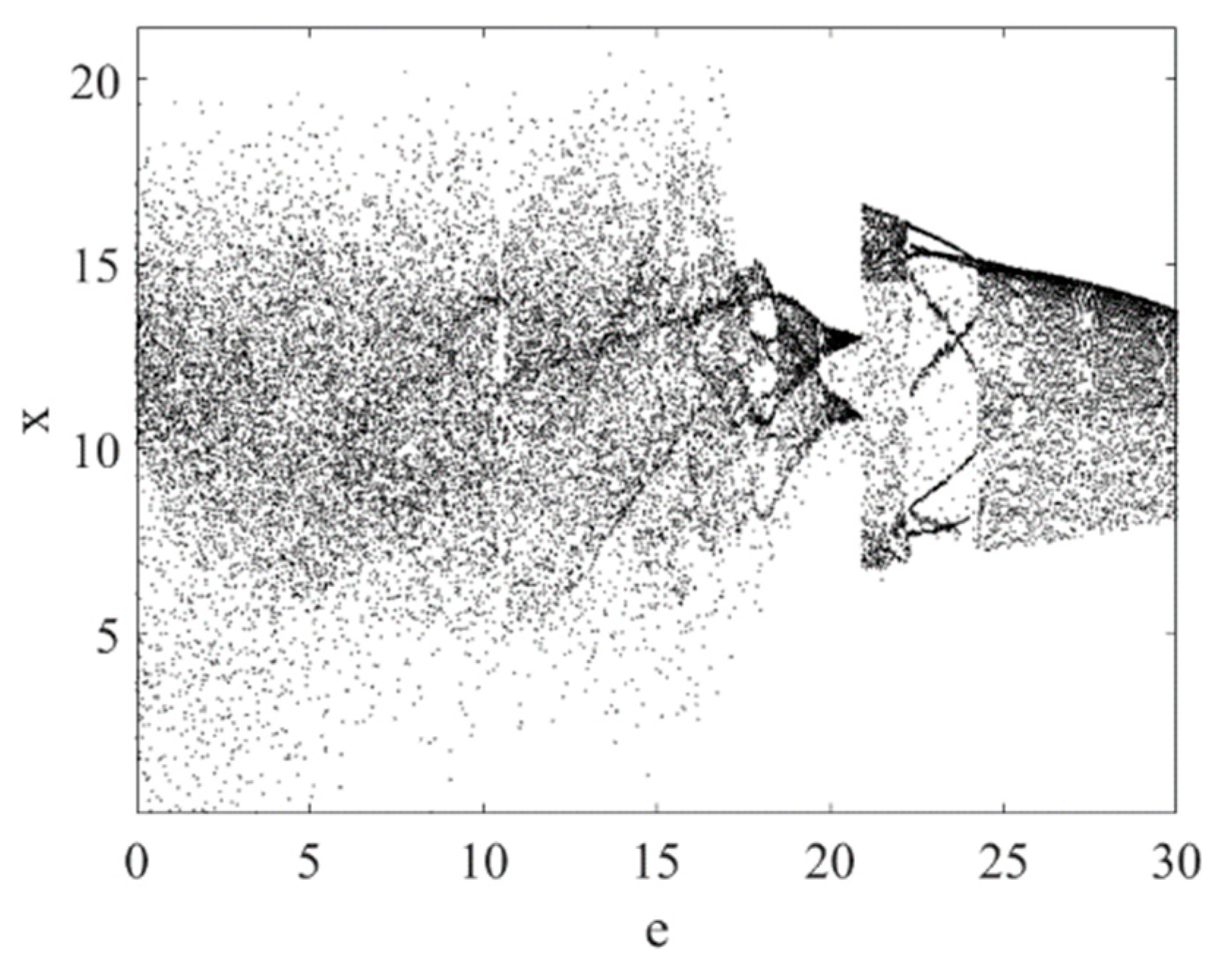
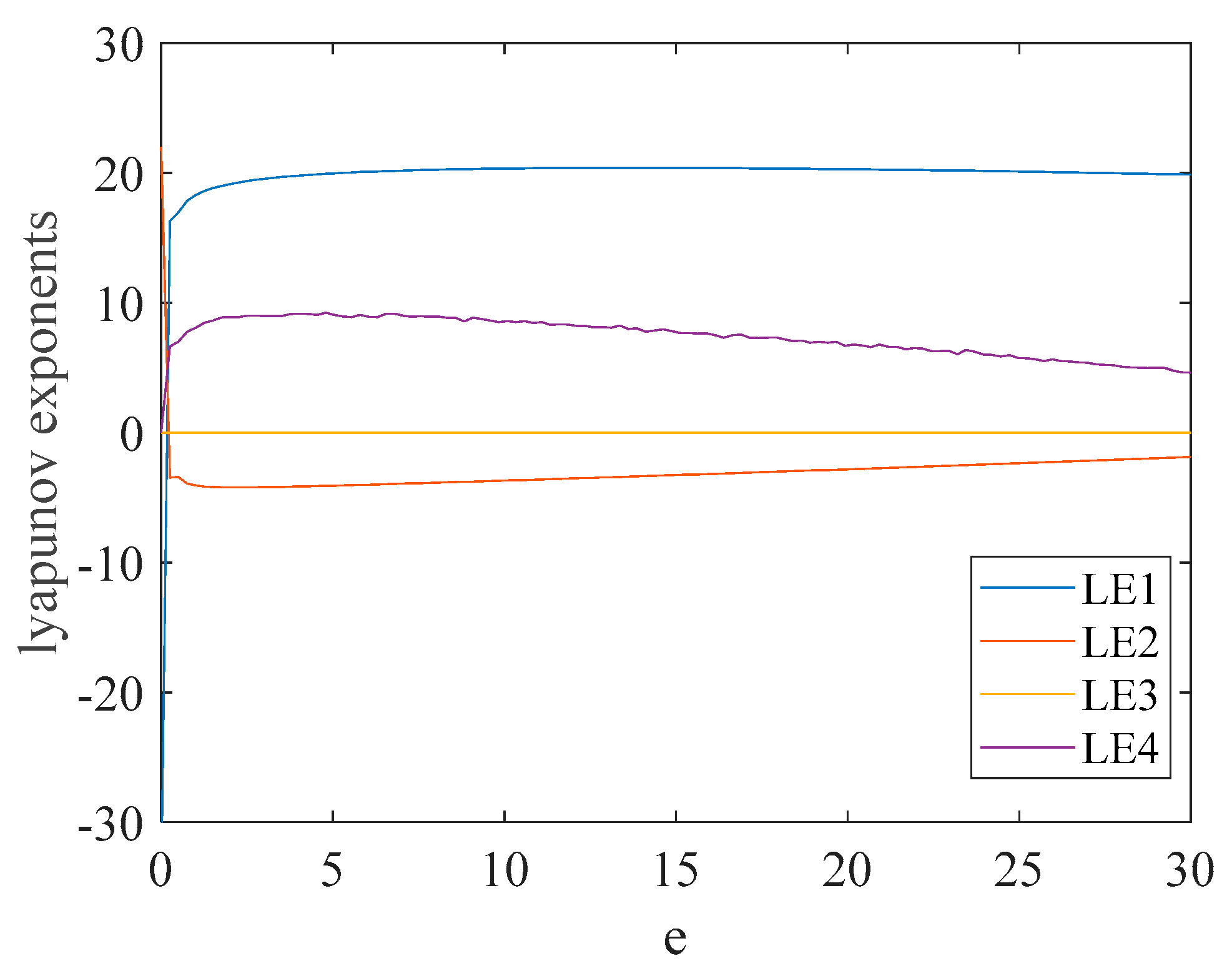
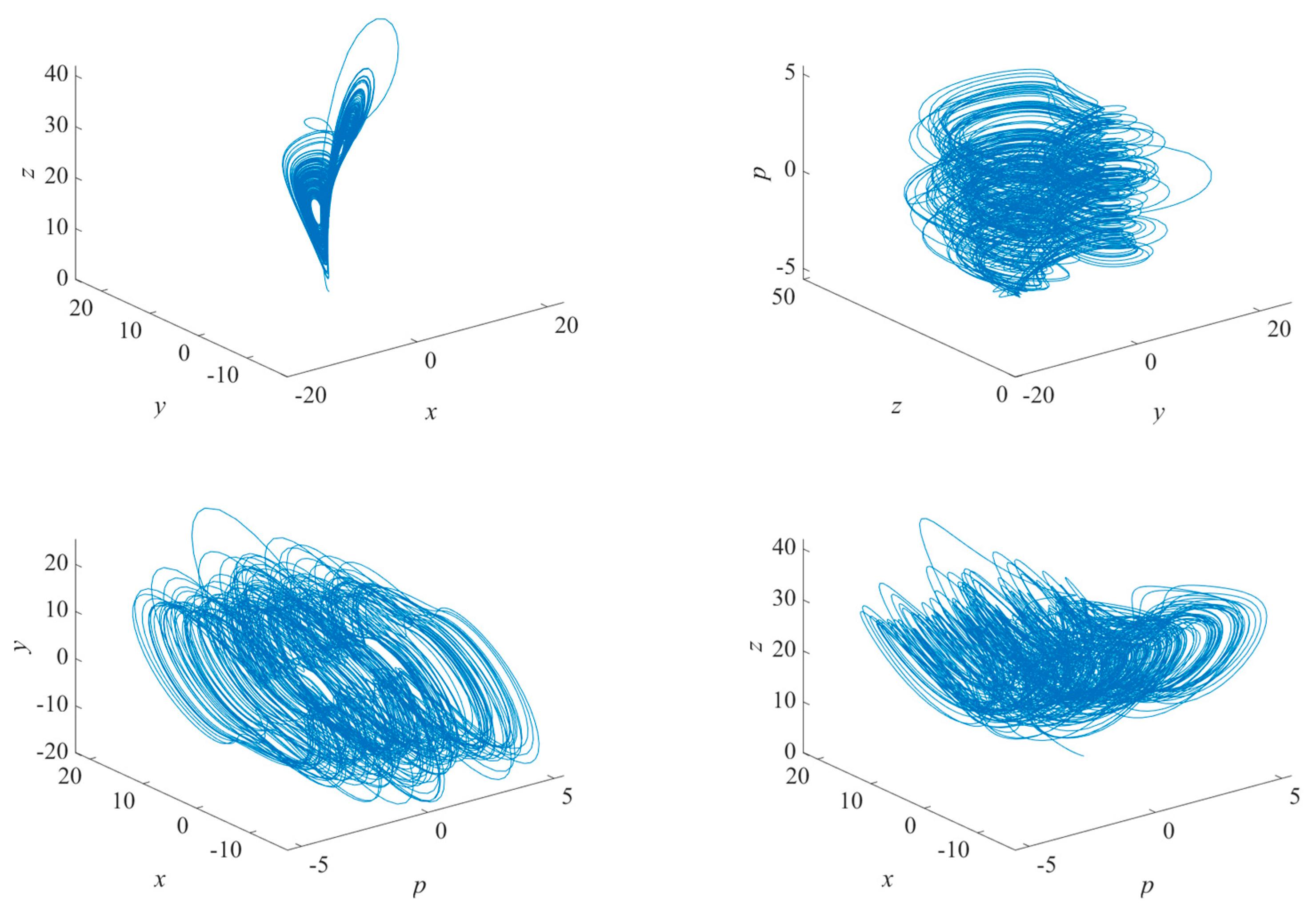
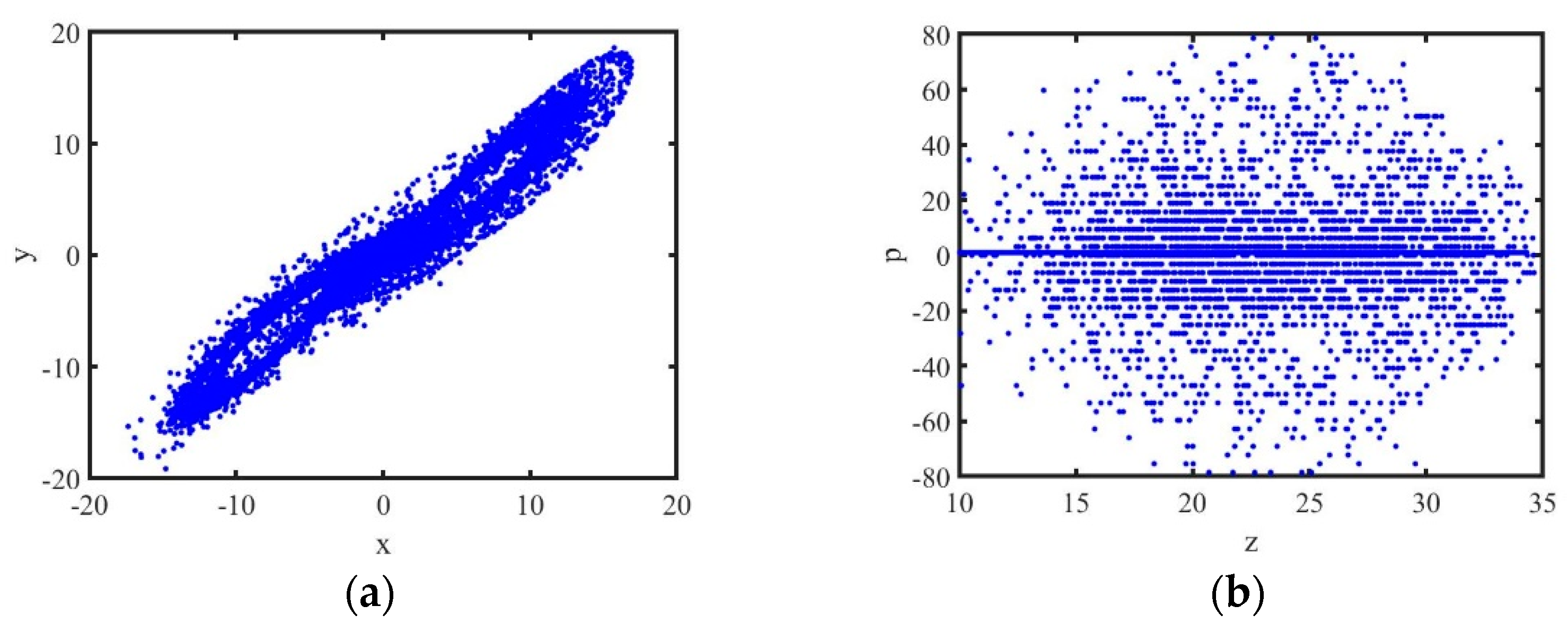

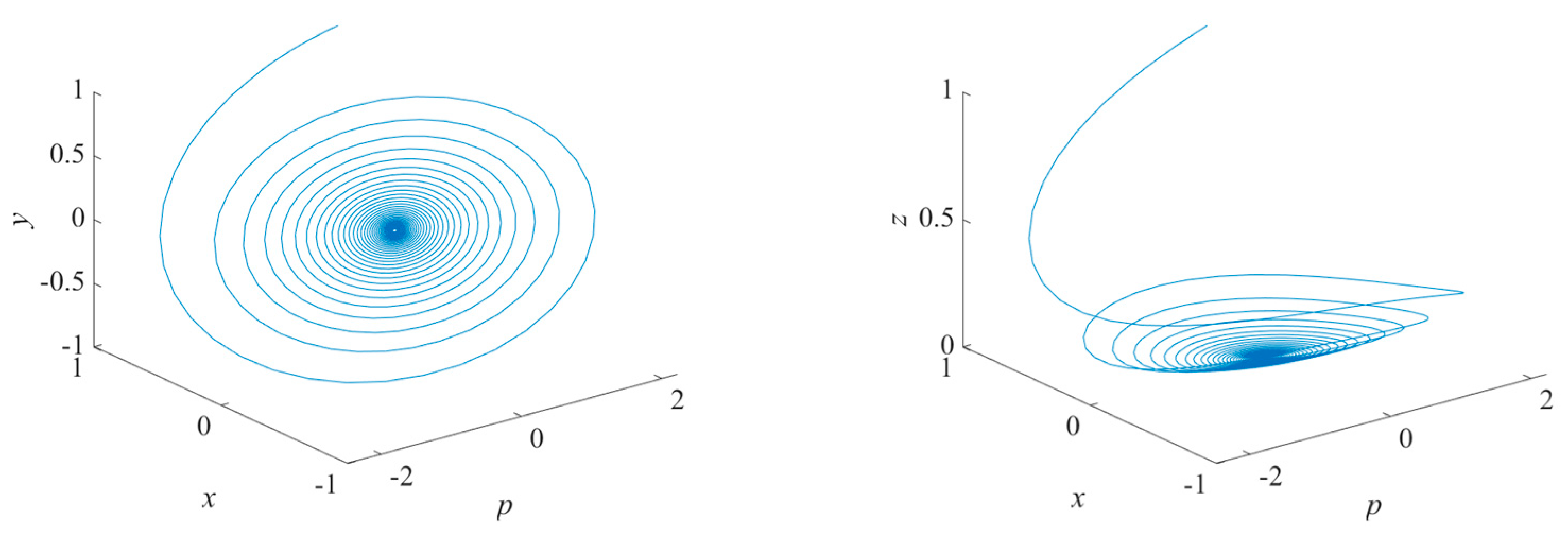
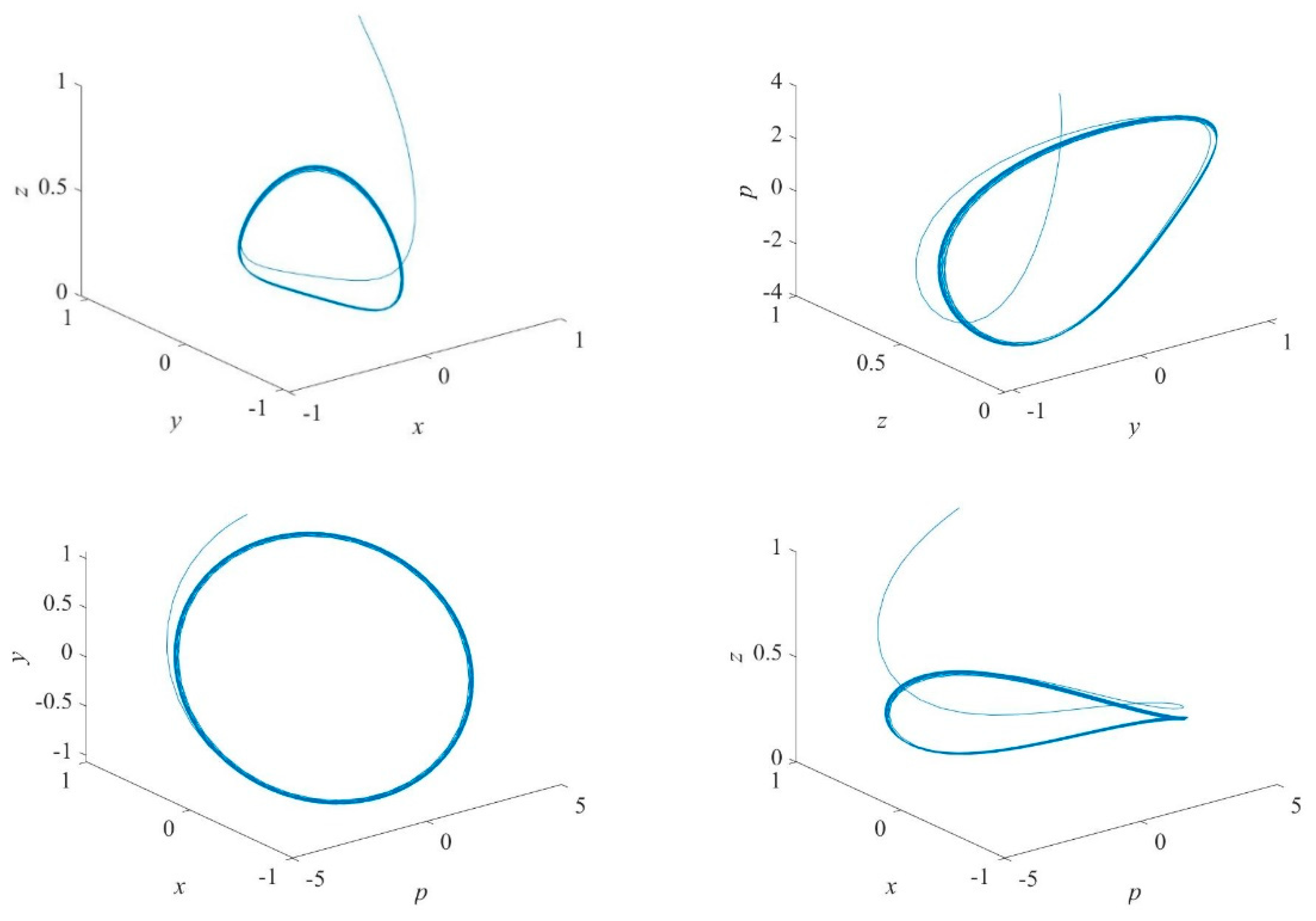

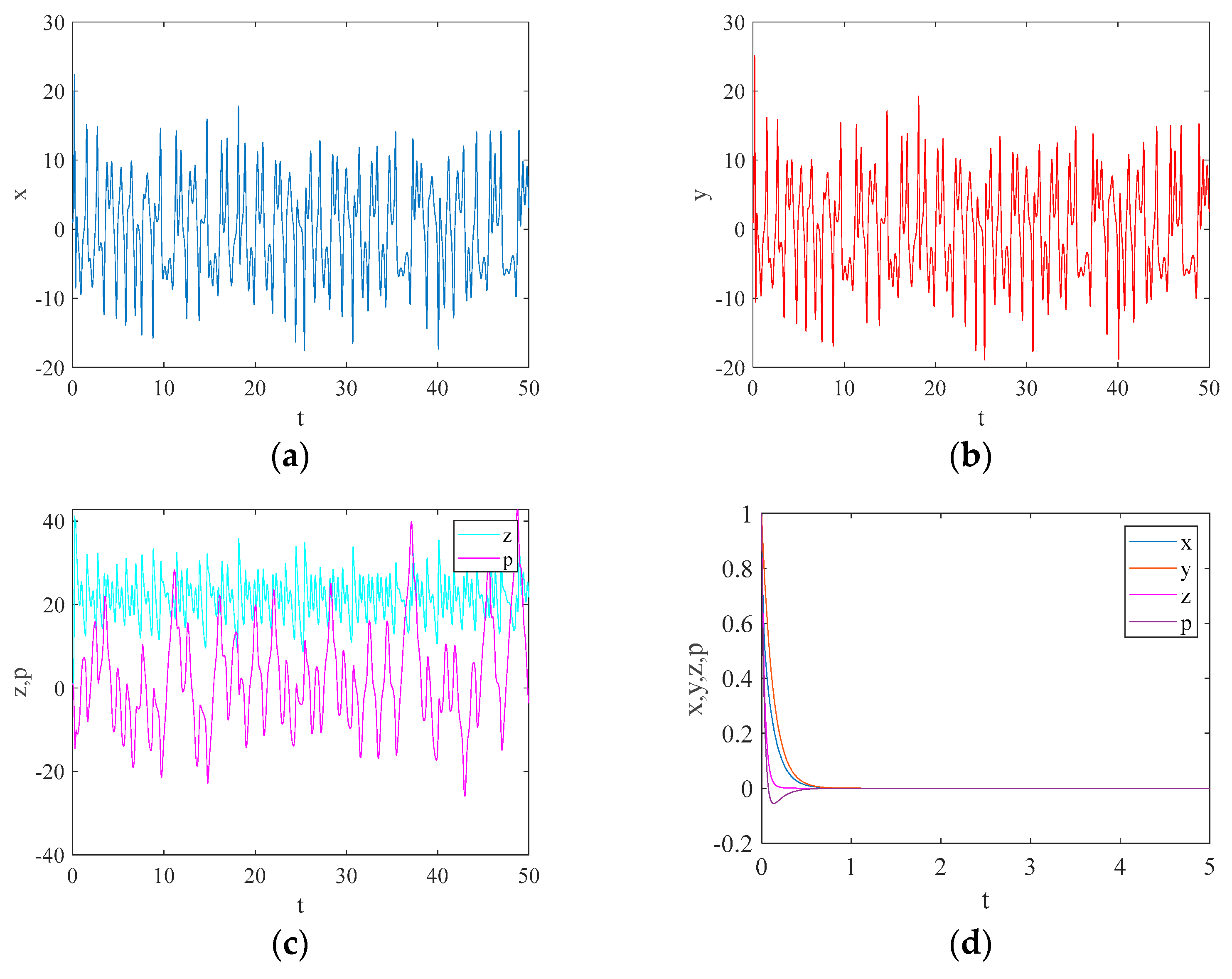
Disclaimer/Publisher’s Note: The statements, opinions and data contained in all publications are solely those of the individual author(s) and contributor(s) and not of MDPI and/or the editor(s). MDPI and/or the editor(s) disclaim responsibility for any injury to people or property resulting from any ideas, methods, instructions or products referred to in the content. |
© 2023 by the authors. Licensee MDPI, Basel, Switzerland. This article is an open access article distributed under the terms and conditions of the Creative Commons Attribution (CC BY) license (https://creativecommons.org/licenses/by/4.0/).
Share and Cite
Liu, Y.; Zhou, Y.; Guo, B. Hopf Bifurcation, Periodic Solutions, and Control of a New 4D Hyperchaotic System. Mathematics 2023, 11, 2699. https://doi.org/10.3390/math11122699
Liu Y, Zhou Y, Guo B. Hopf Bifurcation, Periodic Solutions, and Control of a New 4D Hyperchaotic System. Mathematics. 2023; 11(12):2699. https://doi.org/10.3390/math11122699
Chicago/Turabian StyleLiu, Yu, Yan Zhou, and Biyao Guo. 2023. "Hopf Bifurcation, Periodic Solutions, and Control of a New 4D Hyperchaotic System" Mathematics 11, no. 12: 2699. https://doi.org/10.3390/math11122699
APA StyleLiu, Y., Zhou, Y., & Guo, B. (2023). Hopf Bifurcation, Periodic Solutions, and Control of a New 4D Hyperchaotic System. Mathematics, 11(12), 2699. https://doi.org/10.3390/math11122699




